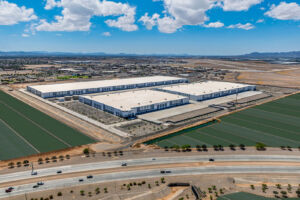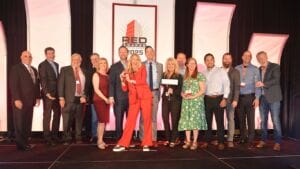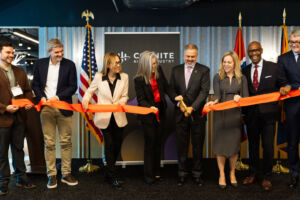 There’s no question, a lot has changed in the West Valley over the last 10-12 years.
There’s no question, a lot has changed in the West Valley over the last 10-12 years.
Old citrus groves and farm fields have been developed into commercial and residential properties like master-planned communities, entertainment centers and business parks, although land still remains for agriculture uses.
Nowadays, the West Valley is becoming increasingly known for new transportation and employment corridors like the Loop 303 and PV|303 as well as super-regional entertainment districts for shopping, dining and entertainment like Westgate in Glendale and P83 in Peoria.
All of which translates to the upgraded quality of life now being enjoyed in the West Valley courtesy of strategic efforts to improve the region’s work-live-play synergy.
Aiding in the development of projects like these and others coming down the pike is the Western Maricopa Coalition (WESTMARC), a public/private partnership of 15 communities, the business community and education sector in the West Valley.
The efforts of WESTMARC, local economic development departments, private and public officials and community members have all contributed over the years in showcasing why the West Valley is a viable place to live, work and play.
It’s catching on too.
The region now boasts a diverse range of restaurants, retail, championship golf courses, hotels, parks, award-winning schools, healthcare facilities and a variety of housing for executives and employees.
The dated-identity of the West Valley as an older retirement community with limited employment, shopping, dining, and entertainment options is largely a misnomer today, says WESTMARC President and CEO Sintra Hoffman.
 She describes the West Valley as a high-quality community with quality amenities that people may not realize.
She describes the West Valley as a high-quality community with quality amenities that people may not realize.
“The West Valley has changed dramatically over the last 10-12 years,” Hoffman explains. “It’s a different community now in terms of buying power, education levels, workforce availability and jobs.”
One shared goal throughout the region’s communities is to attract enough companies to the West Valley so 69 percent of its 1.6-million residents no longer need to commute outside the region to work in other parts of Maricopa County.
Thus, Hoffman and other economic development groups like the Arizona Commerce Authority (ACA) are targeting companies in industries such as: advanced business services, healthcare, STEM occupations, advanced manufacturing, information technology and aerospace.
“Due to a skilled workforce concentration, geographic location and proximity to Luke Air Force Base,” ACA President and CEO Sandra Watson says, “the West Valley has a history of strength in the business and financial services, technology and aerospace and defense industries, and recently has also seen increased growth in the manufacturing and transportation and logistics industries.”
Overall, a majority of activity is occurring near the West Valley’s transportation corridors like the Loop 101 and Loop 303, which is no surprise based on daily traffic counts and the amount of residents and amenities nearby.
The most industrial activity can be seen along the Loop 303 within a 1,600-acre business park known as PV|303, which has already landed several company relocation projects and expansions.
For example, Iris USA, a storage products manufacturer, expanded to Surprise from Japan in 2015, establishing a U.S. headquarters and manufacturing operation that created 100 projected new jobs and a $33 million capital investment.

More recently in December, Chewy.com, a pet products retailer, announced plans for a new e-commerce facility in Goodyear that will create 700 projected new jobs.
“As commercial developers are watching the trend of companies and people moving to West Valley cities, they are advancing new projects to meet the demand of tenants looking for space,” Watson explains.
For Hoffman, what really differentiates the West Valley from the rest of Maricopa County is the quality of life it offers, which keeps evolving and growing as the region matures and more capital investments flow into the area for new projects.
“People realize what we have in the West Valley and we are seeing those investments take shape,” she explains.
INDUSTRIAL’S ROLE
When the West Valley portion of the Loop 303 was completed, it created a much-needed transportation corridor that in turn opened the region to more employment opportunities, especially for e-commerce and manufacturing companies.

One example being developed by Merit Partners and Sunbelt Holdings is PV|303, located in Goodyear and ranked as one of the largest master-planned business parks in the Western U.S. that will include over 20-million square feet of industrial, office and retail space at full buildout.
Joining the ranks of existing companies within PV|303 — like Dick’s Sporting Goods and REI — is the United Parcel Service (UPS), which selected Goodyear as the best location for its new $180 million, 970,000-square-foot package processing hub, which will create 1,500 projected new jobs.
“This is not your grandpa’s manufacturing world any longer,” Hoffman says. “The industrial skillset needed today revolves around robotics and computers, which means the jobs require higher skill and generate higher wages.”
 Pat Feeney, senior vice president at CBRE, focuses on the sale and lease of single and multi-tenant industrial properties, including multiple completed deals and others currently in the works within PV|303.
Pat Feeney, senior vice president at CBRE, focuses on the sale and lease of single and multi-tenant industrial properties, including multiple completed deals and others currently in the works within PV|303.
He remembers when there was little to no industrial users in Goodyear and the most desired industrial submarkets were in the Southwest Valley from 35th to 99th Avenues, Tempe Airport, or Chandler.
Nowadays, Feeney describes constantly fielding calls, giving site tours, and working on contract agreements for industrial properties near the Loop 303 and within PV|303.
Compared to the older industrial submarkets like in the East Valley, Feeney says, the West Valley offers less expensive and more widely available land for new projects as well as cheaper property taxes and more flexible zoning codes.
Looking ahead, Watson is confident the West Valley will continue to grow as a manufacturing and distribution hub.
She notes the recent Nikola Motor decision to build a new manufacturing and R&D headquarters operation in Buckeye, which will create 2,000 projected new jobs and $1 billion in capital investment to the region.
NEW AMENITIES COMING SOON
The area along the Loop 101 Aqua Fria Freeway near the 223-acre Westgate Entertainment District in Glendale is heating up with more retail, hospitality and entertainment projects, in addition to the existing 8-million square-feet of retail at Westgate, which attracts 22-million visitors annually.
With economic development steadily increasing over the past several years, Watson says, commercial real estate development has followed in both key targeted industries and also in the restaurant and retail sectors as a result of the multiplier effect.
Topgolf started construction in November on its fourth Arizona location in Glendale along the northwest corner of Loop 101 and Bethany Home Road, which will total 65,000 square feet and open in late 2018.
In addition to creating 500 full and part-time jobs and serving as an anchor tenant that tends to attract other popular franchises to the area, Topgolf’s economic output in Glendale alone is expected to exceed $264.5 million over a 10-year-period, according to a third-party audit.
Not too far away at the southwest corner of Bethany Home Road and 99th Avenue, Drive Shack is also building a new, 60,000-square-foot, multi-level golf entertainment venue with a bar and restaurant that is expected to produce more than 500 new jobs.
Hoffman says projects like these and the $400 million Desert Diamond West Valley Casino represent a demand from younger demographics in the West Valley and a willingness to spend on higher dollar entertainment.
After opening an interim, slot-machine only casino facility in December 2015, the Tohono O’odham Gaming Enterprise (TOGE) broke ground last December, on the permanent, full-scale home for its Desert Diamond West Valley Casino.

Once complete, it will employ approximately 1,600 people while also complementing the region’s vibrant sports and entertainment attractions, including Glendale’s Westgate Entertainment District and Peoria’s P83 Entertainment District.
Future phases of construction will include a hotel, spa and other resort amenities, but at full buildout, the resort and casino is expected to occupy over one-million square feet and create more than 3,000 jobs.
All of which is good news to the West Valley as it keeps looking ahead at other ways to improve its quality of life, attract more companies in key industries, create additional jobs and provide a truly unique live-work-play synergy throughout its communities.




